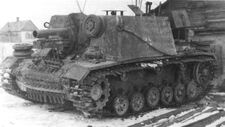m (Jonasguy moved page Kitzingen to Angriffsfahrzeug mit Infanteriegeschütz Typ 43 without leaving a redirect) |
No edit summary Tag: Visual edit |
||
| Line 8: | Line 8: | ||
== History == |
== History == |
||
| − | Experience with the Angriffsfahrzeug Typ 41 during the First Alsatian Conflict prompted the upgrading of most Angriffsfahrzeug vehicles to the HgK Ausf. (''Hochgeschwindigkeitskanone Ausführung''; High-Velocity Cannon version) standard, which entailed replacing the low-velocity gun with a high-velocity anti-tank gun for countering French armor. This left the infantry, however, without an effective anti-emplacement vehicle, since the high-velocity guns mounted on the HgK vehicles were built for destroying tanks. |
+ | Experience with the Angriffsfahrzeug Typ 41 during the First Alsatian Conflict prompted the upgrading of most Angriffsfahrzeug vehicles to the HgK Ausf. (''Hochgeschwindigkeitskanone Ausführung''; High-Velocity Cannon version) standard, also known as Typ 41/3H, which entailed replacing the low-velocity gun with a high-velocity anti-tank gun for countering French armor. This left the infantry, however, without an effective anti-emplacement vehicle, since the high-velocity guns mounted on the HgK vehicles were built for destroying tanks. |
| − | In September 1943, the Army Vehicle Production Board (FzpB; Fahrzeugproduktionsbehörde) put out a contract for converting 30 Angriffsfahrzeug Typ 41 vehicles to mount the InG Typ 35 |
+ | In September 1943, the Army Vehicle Production Board (FzpB; Fahrzeugproduktionsbehörde) put out a contract for converting 30 Angriffsfahrzeug Typ 41 vehicles to mount the [[15 cm InG Typ 35|InG Typ 35/1 15 cm]] Infantry Gun then in use. This gun was quite heavy for an infantry gun, which meant that it was difficult for it to be maneuvered into position. It was thought that mounting the weapon on an armored chassis would rectify this problem, as well as solving the shortage of Assault Guns experienced by the ''[[Begleitbatterien]]. ''Four companies replied to the contract, and Breitenbachstraße Maschinenbau GmbH was chosen to perform the conversion. |
| + | |||
| + | The conversion added a large superstructure to the AFz chassis, housing the InG weapon offset to the right. To the right of the InG, a UMG Typ 36 machine gun was mounted. 30 rounds were carried for the main weapon, while 600 rounds were carried for the machine gun. Despite the increased size of the superstructure to accommodate the Infantry Gun, the armored protection was not increased beyond that found on the Typ 41 Angriffsfahrzeug. |
||
| + | |||
| + | This vehicle was first deployed to the 145th Begleitbatterie in early 1944. Tests with that unit showed that the conversion was relatively successful, as the InG armament was quite powerful and able to demolish fortifications. However, the superstructure's increase in size meant that it posed an easier target for enemy gunners. |
||
| + | |||
| + | Serial production of this type of vehicle was ordered in June 1944 after the successful tests with the 145th Begleitbatterie. This type would go on to equip eight Begleitbatterien by December 1945.{{Assault Guns}} |
||
[[Category:Vehicles]] |
[[Category:Vehicles]] |
||
[[Category:Armored Vehicles]] |
[[Category:Armored Vehicles]] |
||
Revision as of 02:44, 4 December 2017
The Angriffsfahrzeug mit Infanteriegeschütz Typ 43 (abbreviated AFzI Typ 43) was a Blue German Assault Gun based on the Angriffsfahrzeug Typ 41 chassis.
Breitenbachstraße Maschinenbau GmbH.
Design
The AFzI Typ 43 is based off the Sturm-Infanteriegeschütz 33B.
History
Experience with the Angriffsfahrzeug Typ 41 during the First Alsatian Conflict prompted the upgrading of most Angriffsfahrzeug vehicles to the HgK Ausf. (Hochgeschwindigkeitskanone Ausführung; High-Velocity Cannon version) standard, also known as Typ 41/3H, which entailed replacing the low-velocity gun with a high-velocity anti-tank gun for countering French armor. This left the infantry, however, without an effective anti-emplacement vehicle, since the high-velocity guns mounted on the HgK vehicles were built for destroying tanks.
In September 1943, the Army Vehicle Production Board (FzpB; Fahrzeugproduktionsbehörde) put out a contract for converting 30 Angriffsfahrzeug Typ 41 vehicles to mount the InG Typ 35/1 15 cm Infantry Gun then in use. This gun was quite heavy for an infantry gun, which meant that it was difficult for it to be maneuvered into position. It was thought that mounting the weapon on an armored chassis would rectify this problem, as well as solving the shortage of Assault Guns experienced by the Begleitbatterien. Four companies replied to the contract, and Breitenbachstraße Maschinenbau GmbH was chosen to perform the conversion.
The conversion added a large superstructure to the AFz chassis, housing the InG weapon offset to the right. To the right of the InG, a UMG Typ 36 machine gun was mounted. 30 rounds were carried for the main weapon, while 600 rounds were carried for the machine gun. Despite the increased size of the superstructure to accommodate the Infantry Gun, the armored protection was not increased beyond that found on the Typ 41 Angriffsfahrzeug.
This vehicle was first deployed to the 145th Begleitbatterie in early 1944. Tests with that unit showed that the conversion was relatively successful, as the InG armament was quite powerful and able to demolish fortifications. However, the superstructure's increase in size meant that it posed an easier target for enemy gunners.
Serial production of this type of vehicle was ordered in June 1944 after the successful tests with the 145th Begleitbatterie. This type would go on to equip eight Begleitbatterien by December 1945.
| ||||||||
